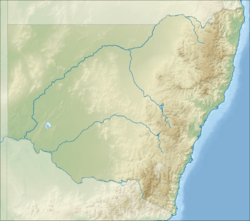Strike-a-Light River facts for kids
Quick facts for kids Strike-a-Light |
|
|---|---|
|
Location of the Strike-a-Light River mouth in New South Wales
|
|
| Other name(s) | Tinderry Creek, Strike-A-Light Creek |
| Country | Australia |
| State | New South Wales |
| Region | South Eastern Highlands (IBRA), Monaro |
| Municipality | Snowy Monaro |
| Physical characteristics | |
| Main source | Great Dividing Range near Jerangle 1,200 m (3,900 ft) |
| River mouth | Bredbo River east of Bredbo 733 m (2,405 ft) 35°58′17″S 149°13′49″E / 35.97139°S 149.23028°E |
| Length | 38 km (24 mi) |
| Basin features | |
| River system | Murrumbidgee catchment, Murray–Darling basin |
The Strike-a-Light River is a river in New South Wales, Australia. It flows all year round, so it's called a perennial stream. This river is part of a bigger water system known as the Murray–Darling basin. It flows through the Snowy Monaro Regional Council area.
The river starts high up on the western side of the Great Dividing Range, which is a large mountain range. It begins near a place called Jerangle. From there, it flows in different directions, mostly north and then south. Along its journey, three smaller streams, called tributaries, join it. Finally, the Strike-a-Light River meets the Bredbo River near Bredbo. The river drops about 464 metres (1,522 ft) in height over its 38-kilometre (24 mi) path.
Animals and Plants of the River
The Strike-a-Light River flows through a special protected area called the Strike-a-Light Nature Reserve. This reserve helps protect the animals and plants that live there.
River Animals
Many different kinds of amphibians live in or near the Strike-a-Light River. Amphibians are animals like frogs and toads that can live both in water and on land. Some of the frogs you might find here include:
- Bibron's toadlet (Pseudophryne bibronii)
- Common eastern froglet (Crinia signifera)
- Pobblebonk (Limnodynastes dumerilii)
- Spotted grass frog (Limnodynastes tasmaniensis)
- Verreaux's tree frog (Litoria verreauxii)
River Plants
The river flows through different types of plant communities, which are like different kinds of forests or woodlands. These include:
- Forests with Scribbly Gum and Apple Box trees, which often have dry shrubs underneath.
- Valley forests where Ribbon Gum trees grow.
- Some areas near the river have also been partly cleared, but still have natural plants.


